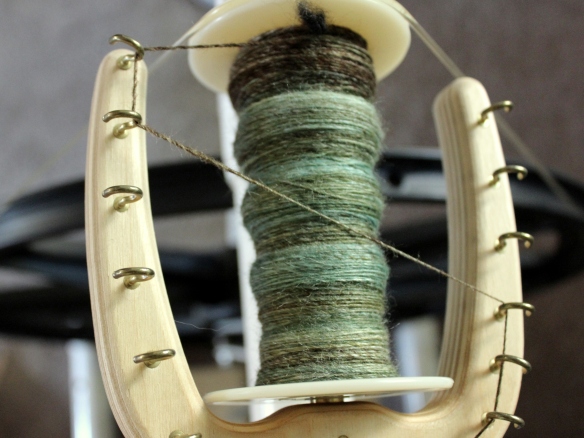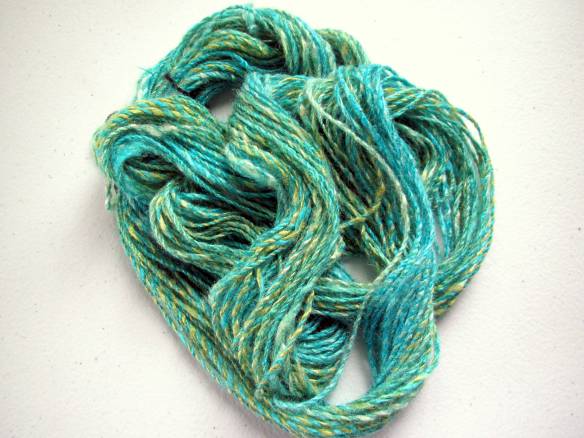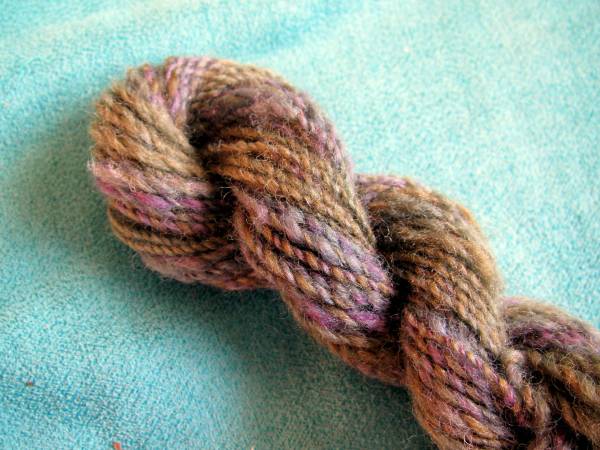Since we’re in the middle of #Spinzilla, this post is chock full of spinning! I shocked myself by working my way through a full 4 oz of the Louet Perendale fiber in one evening (thanks is due to several episodes of Game of Thrones, Season 1).

Spinzilla day 1
When I was too tired to sit up straight in my spinning chair, I curled up on the couch with a pretty little Inglenook Fibers batt and my TexasJeans Russian supported spindle. I really like spinning supported, it’s completely different than wheel or drop spindle spinning, I find it even more relaxing.

Perendale 2-ply
Then last night I plied up my Perendale into a light, fluffy woolen 2-ply. I ended up with 176 yards of worsted-ish weight (just eyeballin’ the weight) which count as 528 yards for Spinzilla [plied yardage + (plied yardage x number of plies)]. That’s nearly half of the total yardage I spun last year already! Seriously, woolen spinning (carded prep and long draw) is wicked fast and makes a delightfully fluffy yarn.

2 oz of Louet Jacob wool
I then knocked out 2 oz worth of Louet Jacob singles, as well. I have a date with the remaining 6 oz as soon as I publish this post.

Honey Cowl, more on this soon.
And then I finished my cowl! (Hopefully some modeled pics on Friday).
I think it’s safe to say that I’m on a roll this Spinzilla and I’m really looking forward to adding everything up by the end of the week! If you spin, are you trying any new techniques this week? If you don’t spin, how are you not tempted?!?! 😉





















 I absolutely adore the way the little pops of color from the silk shine through the soft, white base of the alpaca. The carding blended the fibers enough so that the yarn has a bit of a heathered look from afar, but up close you see all of the variation. Guys, it’s seriously pretty. I almost can’t stand it.
I absolutely adore the way the little pops of color from the silk shine through the soft, white base of the alpaca. The carding blended the fibers enough so that the yarn has a bit of a heathered look from afar, but up close you see all of the variation. Guys, it’s seriously pretty. I almost can’t stand it. I even broke out my
I even broke out my  Once you have your balanced length, you measure it. In the photo above, the top strand measured 12.0 inches and the bottom measured 9.0. You then multiply the length of yarn (including any decimal places) by 100 to calculate that the grist of the top yarn is 1200 yards per pound and the bottom (alpaca/silk) is 900 yards per pound. This means that if I had spun up a full pound of fiber, I would have had 900 yards of yarn at this yarn’s thickness. What’s interesting is that I measured 344 yards for this yarn on my niddy noddy before washing. The ball of yarn weighs 175 grams, or 0.386 pounds. When you multiply 0.386 pounds by 900 yards/pound, you get about 347 yards, which is very close to what I had measured on my niddy noddy, so that’s a nice check!
Once you have your balanced length, you measure it. In the photo above, the top strand measured 12.0 inches and the bottom measured 9.0. You then multiply the length of yarn (including any decimal places) by 100 to calculate that the grist of the top yarn is 1200 yards per pound and the bottom (alpaca/silk) is 900 yards per pound. This means that if I had spun up a full pound of fiber, I would have had 900 yards of yarn at this yarn’s thickness. What’s interesting is that I measured 344 yards for this yarn on my niddy noddy before washing. The ball of yarn weighs 175 grams, or 0.386 pounds. When you multiply 0.386 pounds by 900 yards/pound, you get about 347 yards, which is very close to what I had measured on my niddy noddy, so that’s a nice check!




 If you’d like to read the abstract, you can
If you’d like to read the abstract, you can 

